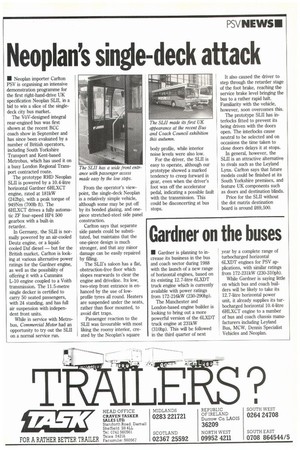Neoplan's single-deck attack
Page 19

If you've noticed an error in this article please click here to report it so we can fix it.
• Neoplan importer Carlton PSV is organising an intensive demonstration programme for the first right-hand-drive UK specification Neoplan SLII, in a bid to win a slice of the singledeck city bus market.
The VEX-designed integral rear-engined bus was first shown at the recent BCC coach show in September and has since been evaluated by a number of British operators, including South Yorkshire Transport and Kent-based Metrobus, which has used it on a busy London Regional Transport contracted route.
The prototype RHD Neoplan SLII is powered by a 10.4-litre horizontal Gardner 6HLXCT engine, rated at 181kW (242hp), with a peak torque of 949Nm (7001b ft), The 6HLXCT drives a fully automatic ZF four-speed 1-ll4 500 gearbox with a built-in retarder.
In Germany, the SLII is normally powered by an air-cooled Deutz engine, or a liquidcooled Daf diesel — but for the British market, Carlton is looking at various alternative power ratings for the Gardner engine, as well as the possibility of offering it with a Cummins L-10 engine coupled to a Voith transmission. The 11.5-metre single decker is certified to carry 50 seated passengers, with 24 standing, and has full air suspension with independent front units.
While in service with Metrobus, Commercial Motor had an opportunity to try out the SLII on a normal service run. From the operator's viewpoint, the single-deck Neoplan is a relatively simple vehicle, although some may be put off by its bonded glazing, and onepiece stretched-steel side panel construction.
Carlton says that separate side panels could be substituted, but maintains that the one-piece design is much stronger, and that any minor damage can be easily repaired by filling, The SLII's saloon has a flat, obstruction-free floor which slopes rearwards to clear the engine and driveline. Its low, two-step front entrance is enhanced by the use of lowprofile tyres all round. Heaters are suspended under the seats, rather than floor mounted, to avoid dirt traps.
Passenger reaction to the SLI1 was favourable with most liking the roomy interior, created by the Neoplan's square body profile, while interior noise levels were also low.
For the driver, the SLII is easy to operate, although our prototype showed a marked tendency to creep forward in gear, even when the driver's foot was off the accelerator pedal, indicating a possible fault with the transmission. This could be disconcerting at bus stops. It also caused the driver to step through the retarder stage of the foot brake, reaching the service brake level bringing the bus to a rather rapid halt. Familiarity with the vehicle, however, soon overcomes this.
The prototype SLII has interlocks fitted to prevent its being driven with the doors open. The interlocks cause neutral to be selected and on occasions the time taken to close doors delays it at stops.
In general, however, the SLII is an attractive alternative to rivals such as the Leyland Lynx, Carlton says that future models could be finished at its South Yorkshire premises, and feature UK components such as doors and destination blinds.
Price for the SLI1 without the dot matrix destination board is around £69,500.
















































































